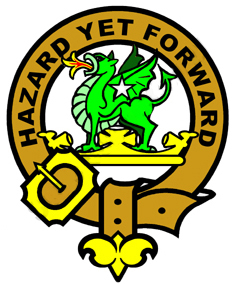Seton Clan
Seton Clan Crest: On a ducal coronet, a dragon vert, spouting fire proper, wings elevated and charged with a star argent.
Seton Clan Motto: Hazard Yet Forward
Seton Clan History: This surname comes from the village of Sai in Normandy, and the first member of the Seton family on record in Scotland is an Alexander de Seton who witnessed a Charter for David I in 1150. The family gained prominence in the late-13th century when Sir Christopher Seton married Lady Christina Bruce, a sister of Robert the Bruce. Sir Christopher is credited with saving Bruce's life when the King was unseated from his horse at the Battle of Methven in 1306. He was not so fortunate himself in that he was taken prisoner and taken to London where he was brutally executed.
In 1320, Sir Alexander Seton, presumably Sir Christopher's brother, was a signatory of the Declaration of Arbroath. He became Governor of Berwick, but all of his three sons predeceased him so that his estates passed to his daughter Margaret, and it is her descendants who became lords Seton.
One of William, Lord Seton's sons married Elizabeth de Gordon, forebear of the marquesses of Huntly. George, 3rd Lord Seton died at the Battle of Flodden in 1513. The 5th Lord Seton attended the wedding of Mary Queen of Scots to the Dauphin of France and later served as Master of the Royal Household. After the murder of the Queen's Secretary David Rizzio, he helped Mary to escape to Seton Castle, in East Lothian. Similarly she went to Seton Castle following the death of her husband, Lord Darnley, and it was there that her marriage contract with the 4th Earl of Bothwell was drawn up.
After the Queen's defeat at the Battle of Langside, the 5th Lord Seton took shelter in Flanders, returning to become one of the judges who officiated at the trial of the Earl of Morton, who was accused of Darnley's murder. The 5th Lord's son, Alexander Seton, became Chancellor of Scotland and, in 1606, was made Earl of Dunfermline by James VI. Six years earlier, another son, Robert, had been created Earl of Winton.
The 4th Earl of Dunfermline forfeited his titles when he supported Viscount Dundee in 1680. The Winton titles were also lost when the 5th Earl of Winton took part in the 1715 Jacobite Uprising.
Alexander Seton (1621-91) was the son of 3rd Earl of Winton and was excommunicated for refusing to accept the Covenant of 1644. Mary Seton , daughter of George, 5th Lord Seton, was one of Mary Queen of Scots' Mairies. She never married and remained with the Queen until her execution at Fortheringay in 1587. Afterwards, she retired to a nunnery in France.
Surname distribution in Scotland: The Seton name is most commonly found in Ayrshire and Dumfries and Galloway (Dumfriesshire, Kirkcudbrightshire and Wigtownshire).
Places of Interest: Seton Tower at Fyvie Castle in Aberdeenshire. This was built for Alexander Seton, 1st Earl of Dunfermline. Pitmedden, Aberdeenshire, is a 17th century garden once owned by Sir Alexander Seton, and today managed by National Trust for Scotland.
Seton House in East Lothian was rebuilt by Robert Adam in 1790 on the site of Seton Palace, home of the 5th Lord Seton. Mary Queen of Scots came here after the deaths of both her secretary, David Rizzio, and her husband, Lord Darnley.
Seton Collegiate Church contains an effigy of the 3rd Lord Seton, killed at the Battle of Flodden in 1513. Winton Castle, Pencaitland, East Lothian, was built by the 4th Lord Seton in 1480, but destroyed by the English in 1544. The later mansion was built in 1619 by the 3rd Earl of Winton. It is today owned by the Ogilvys of Inverquharity.
Gogar Castle, Edinburgh, was given to Alexander Seton by Robert I. Niddry Castle, beside Winchburgh, in West Lothian is a ruined keep once owned by the Setons. Mary Queen of Scots came here after her escape from Loch Leven Castle. Pinkie House at Musselburgh, Midlothian was the home of Alexander Seton, first Earl of Dunfermline. It is now part of Loretto School.
Buy Seton Clan membership display certificates.

